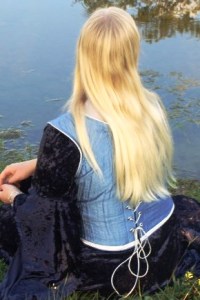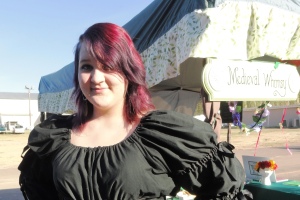This post has been brewing for a long time. It is as close as I get to posting something that might be controversial, but sometimes one feels that something must be said, and this is one of those times for me.
I have four daughters, all of whom have beautiful blonde hair. Lina’s and Lucy’s is a beautiful golden blonde:


Mary’s is closer to platinum:

and Mercy’s is a darker honey blonde.

Over the last several years, my three younger daughters have experimented with different looks. Mary likes to have blue in her hair—sometimes a little and sometimes a lot.

Mercy started off dying her hair red, then black, which she thought was temporary but which was not.

More recently she has kept one side of her head shaved and has dyed the under-layer a dark brown to contrast with her natural blonde.

Lucy has had almost any color you can think of:

black,

red,

pink, purple, blue, mint green, turquoise. She hasn’t tried canary yellow or orange yet, primarily because those colors look ghastly on someone who is a natural blonde.
Have I been a fan of all these color and/or style changes? No. Some of them have made me cry. But the reality is, it’s not my hair and I decided long ago that this was an issue I was not going to take a stand on, and we’ll get to that in a minute, because the first point I want to make is that many of our friends and acquaintances made it clear they disapproved of my daughters’ hair color choices. In fact, my daughters have often felt shunned, rejected, judged, and excluded for that one reason alone.
Imagine sitting in church with your blue-streaked hair and hearing the preacher talk about rebellious “bad” girls who are promiscuous, drug-using godless losers with blue hair. That is pretty devastating if you happen to be a committed Christian who loves the Lord–and who also loves having blue hair. Yet among many Christians we know, “unnatural” hair colors are lumped in with actual sins such as promiscuity, drunkenness, and rebellion against parents and/or God.
It’s true that when I was Lucy’s age, “good” girls did not dye their hair green, blue, or any other color. It was unheard of in Christian circles. The only church-sanctioned hair dyeing involved coloring out the gray as one aged. When I was twelve, an elderly man at church asked me if I bleached my hair, presumably because it was such a light blonde from the hours I spent outdoors.
On the one hand, I thought his question was hilarious because it was so absurd. On the other hand, I objected strongly to the tone of the question. He asked it in the tone one would expect from someone asking, “Are you sleeping around and shooting up heroin behind your parents’ backs?”
Time marches on, though, and we live in a very different world now. Things that once marked someone as a rebel are now just forms of artistic expression—hair color, hair style, tattoos, piercings, etc. Yet despite large numbers of young Christians choosing to express themselves in these ways, the church has not caught on to the fact that for many, if not most of them, these choices are not a form of rebellion but of artistic expression. I don’t understand it (and I don’t have to), but they see their bodies as blank canvases to be decorated. My daughters are still seen as rebellious and/or sinful because of their hair color, even though it has no bearing whatever on their faith and is not forbidden in scripture.
The attitude behind this is the time-honored fallback of humanity in general and Christians in particular: “You are NOT LIKE ME and therefore I must shun you.” “Because my mother would never have let me dye my hair, it must be a sin and therefore you are sinning and I must reject you.” “Because the preacher says people who dye their hair purple are rebelling against God, you are clearly in rebellion against God and I must have nothing to do with you. In fact, I won’t even acknowledge your presence, let alone speak to you.”
And yes, this has happened to my daughters. At first I was clueless and didn’t notice it. Then one of my daughters mentioned to me that there was a family in our church who had never spoken to her—not even in greeting. She believed it was because of her hair color, since that was the only thing about her that was “different.”
I began to observe more closely when we were at church. My daughter was right. She was shunned, ignored and rejected not just by that family, but by others too. I was deeply hurt and felt powerless to fight it. This type of thing continues to happen all the time, especially to Lucy whose bright hair is hard to ignore! I am also quite certain that I too am shunned to some degree by other mothers who disapprove of my decision to allow my girls free rein with their hair once they reach their teens.
What makes this even harder to take is that there are so many young people guilty of actual sin who still seem to be accepted by the very people who reject my daughters because of their hair. Sometimes, maybe, it’s because the sin doesn’t come to light unless someone gets pregnant, for instance, or arrested. Do I think these people should be shunned? No. I think it’s better to assume the best about everyone and still be loving toward them even if you find out your assumptions were incorrect. No one that I’ve ever met got rejected or despised into the kingdom of God.
A few weeks ago, we were looking into summer ministry options for Lucy. Since last year’s planned trip to Germany fell through, we want to make sure we find a viable option for her this year. We approached a ministry we have long been familiar with, and which works in Europe. They said they’d be happy to have Lucy join them—but only if she returned her hair to its natural blonde color.
Well, Lucy was willing to do this. Over the next couple of weeks, we spent a great deal of money and Lucy spent a great deal of time and effort trying to bleach the color out of her hair so that it could be blonde again. After all that work, it was still a light pastel green. We realized that if she was going to meet the hair requirement for that mission, we had two choices: either we could spend hundreds of dollars we don’t possess to get it done by a professional, or we could shave her head and hope her hair would be at least an inch long by the time she left!
Neither of these options appealed to us, and during the process of trying to conform to the mission’s demand, Lucy found herself wondering why they could not accept her as she was. I could see where her hair color might be an issue if she was going to be working with the elderly, but her heart is to work with urban youth. In that setting, her hair is an asset and a conversation starter. You wouldn’t believe how many positive comments she gets from total strangers!
The message she was getting from the mission was, “We would love to have you come work with us as long as you change a bunch of stuff about yourself to conform to our notion of what a Christian should be and look like.” Please note that Lucy is not living in any kind of habitual sin or rebellion–she has simply chosen a more vivid hair color than most other girls her age.
I had to agree with Lucy that maybe that particular organization wasn’t a good fit for her. I asked her if she’d be willing to consider going to Bolivia. She’d never really thought in terms of South America, but she said she was open to it. So I wrote to my dear sweet friend Elizabeth who with her husband has a wonderful ministry in Bolivia. I asked if they could use Lucy’s help for several weeks and warned her that Lucy has blue hair. I received an enthusiastic YES in response–and an assurance that they don’t care one bit what color Lucy’s hair is.
So guess where Lucy will be going this summer? We have just begun to work on raising the necessary financial support, but I am so thrilled to think she will be welcomed with open arms as she is to share in our friends’ ministry.
I admit that I wondered how people would react to Lucy’s hair when we got to the Master’s Mission for our spring break trip. Would they judge and shun her there too? No. She got lots of comments on her hair, all of them positive, and from some of the most godly people I know. Several of the staff families up there have girls with parts of their hair dyed blue or some other color. After all the disapproval she’s endured, this was balm to her battered soul—and to mine too.
I will confess, the whole hair color thing caught me off guard. My daughters all have such gorgeous natural hair, it never occurred to me they’d want to change it. To be honest, I still don’t understand it at all. I can’t relate to it in any way. I had that same same knee-jerk reaction—it must be bad because that’s what I’ve always been told.
But because it was my daughters who wanted to do it, and because I love them very much, I had to consider it. I had to think it through. And I was forced to admit that having any particular hair color is not a sin. I can’t find any support for that in the Bible, anywhere. I could see where if, say, it was traditional for all prostitutes to have green hair, and I wanted to dye my hair green, that might be a real issue and might send the wrong message. But if it’s just a matter that someone wants to have blue hair, and I don’t have blue hair, how does that give me the right to shun them?
So here’s what I came up with. Having colorful hair is a personal choice, like having orange fingernails or wearing makeup. It’s not a sin. It’s not a sign of rebellion unless, of course, the person in question has been expressly forbidden to do it (which was the case with one of my daughter’s friends). I don’t have to like the hair color choice that you might make or that my daughters make. It doesn’t make them less spiritual, less lovable, or less amazing and wonderful. It just makes them less blonde!
I know that some parents are horrified by my position on this. Many, if not most of the parents I know have strictly forbidden their girls to dye their hair any color which is not “natural.” In some cases, it has caused very hurt feelings and has damaged relationships in the family. To me, this is not a matter worth alienating my daughters for. I mean, for crying out loud, it’s just hair. Hair grows. It can be changed to another color if the current one isn’t what you want for the rest of your life.
To use another analogy, it’s like jewelry. Some people wear a lot of jewelry—big, bold jewelry—and they change it often. Other people, like me, wear the same little gold hoop earrings 99% of the time and are perfectly happy. It’s about how we want to present ourselves to the world. My appearance tells the world that I’m a conservative, old-fashioned matron. Lucy’s appearance tells the world that she’s bold, creative, and adventurous. In my opinion, there is nothing wrong with that.
The more time goes by, and the more I see my daughters being harshly judged for something so inconsequential, the more it irritates me. My daughters’ blue hair is so very noticeable and vibrant, and if you think that’s a sin, then I suppose you will judge and reject them as so many others do—but I really hope you won’t.

Final note: I have a feeling that some who read this are going to want to re-post it. Go right ahead. Just send me a link so I can visit!
Linda, I’m in total agreement with you. It is not a battle that I’m willing to lose the whole war over. If Jesus appeared right now, He would embrace all color of hair with the right heart.
LikeLike
The kind of congregations that judge people over hair color or other externalities are the ones that are going to lose young people in droves. Our young people are far more accepting of these kinds of differences. As you say, there is zero scriptural reason to forbid hair coloring. This is a cultural issue, and congregations that shun people over cultural issues are forgetting that Jesus never shunned anyone.
LikeLike
The only remotely scriptural viable support for the disapproval of make-up, earrings, tattoos, nail polish, clothes that are ‘too loud,’ and ‘unnatural’ hair colors, is that we aren’t supposed to look like the world, and as our bodies are a temple of the Holy Spirit, we are not to alter it. If we spent less time tearing into people for the externals and more time disciplining people’s internals, imagine what we could accomplish?
LikeLike
I meant to say the only scriptural reason that I’ve had leveled at me. I’ve also been told that these things are wrong because they draw attention to yourself. Externals are easy to focus on since they are right there, and it makes an excellent smoke screen for your own mess when you are busy pointing out how ‘unholy’ everyone else is. I’m far more concerned with the hearts of my students and their developing value systems than with putting them off ‘worldly’ adornment. Teen age expressions of individuality will pass away, but a heart hardened to Jesus is a lot harder to fix.
LikeLike